Airship
An airship or dirigible balloon is a type of aerostat or lighter-than-air aircraft that can navigate through the air under its own power.[1] Aerostats gain their lift from a lifting gas that is less dense than the surrounding air.
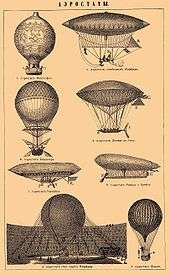
In early dirigibles the lifting gas used was hydrogen, due to its high lifting capacity and ready availability. Helium gas has almost the same lifting capacity and is not flammable, unlike hydrogen, but is rare and relatively expensive. Significant amounts were first discovered in the United States and for a while helium was only used for airships in that country.[2] Most airships built since the 1960s have used helium, though some have used hot air.[note 1]
The envelope of an airship may form the gasbag, or it may contain a number of gas-filled cells. An airship also has engines, crew, and optionally also payload accommodation, typically housed in one or more gondolas suspended below the envelope.
The main types of airship are non-rigid, semi-rigid, and rigid.[3] Non-rigid airships, often called "blimps", rely on internal pressure to maintain their shape. Semi-rigid airships maintain the envelope shape by internal pressure, but have some form of supporting structure, such as a fixed keel, attached to it. Rigid airships have an outer structural framework that maintains the shape and carries all structural loads, while the lifting gas is contained in one or more internal gasbags or cells.[4] Rigid airships were first flown by Count Zeppelin and the vast majority of rigid airships built were manufactured by the firm he founded. As a result, rigid airships are often called zeppelins.[5]
Airships were the first aircraft capable of controlled powered flight, and were most commonly used before the 1940s; their use decreased as their capabilities were surpassed by those of aeroplanes. Their decline was accelerated by a series of high-profile accidents, including the 1930 crash and burning of the British R101 in France, the 1933 and 1935 storm-related crashes of the twin airborne aircraft carrier U.S. Navy helium-filled rigids, the USS Akron and USS Macon respectively, and the 1937 burning of the German hydrogen-filled Hindenburg. From the 1960s, helium airships have been used where the ability to hover for a long time outweighs the need for speed and manoeuvrability, such as advertising, tourism, camera platforms, geological surveys and aerial observation.
Terminology
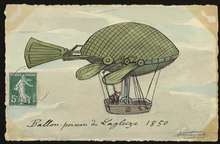
Airship
During the pioneer years of aeronautics, terms such as "airship", "air-ship", "air ship" and "ship of the air" meant any kind of navigable or dirigible flying machine.[6][7][8][9][10][11] In 1919 Frederick Handley Page was reported as referring to "ships of the air," with smaller passenger types as "air yachts."[12] In the 1930s, large intercontinental flying boats were also sometimes referred to as "ships of the air" or "flying-ships".[13][14] Nowadays the term "airship" is used only for powered, dirigible balloons, with sub-types being classified as rigid, semi-rigid or non-rigid.[3] Semi-rigid architecture is the more recent, following advances in deformable structures and the exigency of reducing weight and volume of the airships. They have a minimal structure that keeps the shape jointly with overpressure of the gas envelope.[15][16]
Aerostat
An aerostat is an aircraft that remains aloft using buoyancy or static lift, as opposed to the aerodyne, which obtains lift by moving through the air. Airships are a type of aerostat.[3] The term aerostat has also been used to indicate a tethered or moored balloon as opposed to a free-floating balloon.[17] Aerostats today are capable of lifting a payload of 3,000 pounds (1,400 kg) to an altitude of more than 4.5 kilometres (2.8 mi) above sea level.[18] They can also stay in the air for extended periods of time, particularly when powered by an on-board generator or if the tether contains electrical conductors.[18] Due to this capability, aerostats can be used as platforms for telecommunication services. For instance, Platform Wireless International Corporation announced in 2001 that it would use a tethered 1,250 pounds (570 kg) airborne payload to deliver cellular phone service to a 140 miles (230 km) region in Brazil.[19][20] The European Union's ABSOLUTE project was also reportedly exploring the use of tethered aerostat stations to provide telecommunications during disaster response.[21]
Dirigible
Airships were originally called dirigible balloons, from the French ballon dirigeable often shortened to dirigeable (meaning "steerable", from the French diriger – to direct, guide or steer). This was the name that inventor Henri Giffard gave to his machine that made its first flight on 24 September 1852.
Blimp
A blimp is a non-rigid aerostat.[22] In British usage it refers to any non-rigid aerostat, including barrage balloons and other kite balloons, having a streamlined shape and stabilising tail fins.[23]
Zeppelin
The term zeppelin originally referred to airships manufactured by the German Zeppelin Company, which built and operated the first rigid airships in the early years of the twentieth century. The initials LZ, for Luftschiff Zeppelin (German for "Zeppelin airship"), usually prefixed their craft's serial identifiers.
Streamlined rigid (or semi-rigid) airships are often referred to as "Zeppelins", because of the fame that this company acquired due to the number of airships it produced.[24][25]
Classification
Airships are classified according to their method of construction into rigid, semi-rigid and non-rigid types.[3]
Rigid airships
A rigid airship has a rigid framework covered by an outer skin or envelope. The interior contains one or more gasbags, cells or balloons to provide lift. Rigid airships are typically unpressurised and can be made to virtually any size. Most, but not all, of the German Zeppelin airships have been of this type.
Semi-rigid airships
A semi-rigid airship has some kind of supporting structure but the main envelope is held in shape by the internal pressure of the lifting gas. Typically the airship has an extended, usually articulated keel running along the bottom of the envelope to stop it kinking in the middle by distributing suspension loads into the envelope, while also allowing lower envelope pressures.
Non-rigid airships
Non-rigid airships are often called "blimps". Most, but not all, of the American Goodyear airships have been blimps.
A non-rigid airship relies entirely on internal gas pressure to retain its shape during flight. Unlike the rigid design, the non-rigid airship's gas envelope has no compartments. It typically has smaller internal bags or "ballonets". At sea level, these are filled with air. As altitude is increased, the lifting gas expands and air from the ballonets is expelled through valves to maintain the hull's shape. To return to sea level, the process is reversed: air is forced back into the ballonets by scooping air from the engine exhaust and using auxiliary blowers.
Construction
.jpg)
Envelope
The envelope itself is the structure, including textiles that contain the buoyant gas. Internally two ballonets placed in the front part and in the rear part of the hull contains air.[28]
The problem of the exact determination of the pressure on an airship envelope is still problematic and has fascinated major scientists such as Theodor Von Karman.[29]
A few airships have been metal-clad, with rigid and nonrigid examples made. Each kind used a thin gastight metal envelope, rather than the usual rubber-coated fabric envelope. Only four metal-clad ships are known to have been built, and only two actually flew: Schwarz's first aluminum rigid airship of 1893 collapsed,[30] while his second flew;[31] the nonrigid ZMC-2 built for the U.S. Navy flew from 1929 to 1941 when it was scrapped as too small for operational use on anti-submarine patrols;[32] while the 1929 nonrigid Slate Aircraft Corporation City of Glendale collapsed on its first flight attempt.[33][34]
Lifting gas
Thermal airships use a heated lifting gas, usually air, in a fashion similar to hot air balloons. The first to do so was flown in 1973 by the British company Cameron Balloons.[35]
Gondola
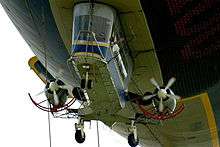
Propulsion and control
Small airships carry their engine(s) in their gondola. Where there were multiple engines on larger airships, these were placed in separate nacelles, termed power cars or engine cars.[36] To allow asymmetric thrust to be applied for maneuvering, these power cars were mounted towards the sides of the envelope, away from the centre line gondola. This also raised them above the ground, reducing the risk of a propeller strike when landing. Widely spaced power cars were also termed wing cars, from the use of "wing" to mean being on the side of something, as in a theater, rather than the aerodynamic device.[36] These engine cars carried a crew during flight who maintained the engines as needed, but who also worked the engine controls, throttle etc., mounted directly on the engine. Instructions were relayed to them from the pilot's station by a telegraph system, as on a ship.[36]
Environmental benefits
The main advantage of airships with respect to any other vehicle is of environmental nature. They require less energy to remain in flight, if compared to any other air vehicle.[37][38] Nuclear power can provide 100% of the ships propultion and heating requirements for passengers, using direct heat to air propultion and themocouple effect electricity. It could also operate in more extreme conditions, such as polar winter northern light cruises, emitting no fossil fuel combustion gas and no dumping of any of the chemical sludge waste associated with solar. A solar-powered airship would be estimated to only use 8 percent of the fuel required by jet aircraft.[39] Furthermore, utilizing the jet stream could allow for a faster and more energy-efficient cargo transport alternative to maritime shipping.[40] The International Air Transport Association has called for increasing the use of airships in an effort to tackle greenhouse gas emissions, claiming 80-90% reductions relative to conventional aircraft.[41] This is one of the reasons why China has embraced their use recently.[42]
History
Early pioneers
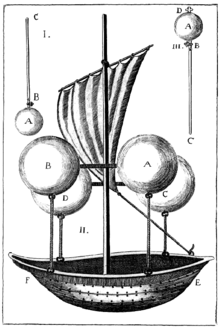
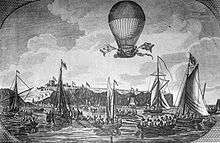
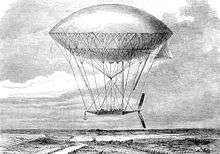
17th–18th centuries
In 1670, the Jesuit Father Francesco Lana de Terzi, sometimes referred to as the "Father of Aeronautics",[43] published a description of an "Aerial Ship" supported by four copper spheres from which the air was evacuated. Although the basic principle is sound, such a craft was unrealizable then and remains so to the present day, since external air pressure would cause the spheres to collapse unless their thickness was such as to make them too heavy to be buoyant.[44] A hypothetical craft constructed using this principle is known as a Vacuum airship.
A more practical dirigible airship was described by Lieutenant Jean Baptiste Marie Meusnier in a paper entitled "Mémoire sur l’équilibre des machines aérostatiques" (Memorandum on the equilibrium of aerostatic machines) presented to the French Academy on 3 December 1783. The 16 water-color drawings published the following year depict a 260-foot-long (79 m) streamlined envelope with internal ballonnets that could be used for regulating lift: this was attached to a long carriage that could be used as a boat if the vehicle was forced to land in water. The airship was designed to be driven by three propellers and steered with a sail-like aft rudder. In 1784, Jean-Pierre Blanchard fitted a hand-powered propeller to a balloon, the first recorded means of propulsion carried aloft. In 1785, he crossed the English Channel in a balloon equipped with flapping wings for propulsion and a birdlike tail for steering.[45]
19th century
The 19th century saw continued attempts to add methods of propulsion to balloons. The Australian William Bland sent designs for his "Atmotic Airship" to the Great Exhibition held in London in 1851, where a model was displayed. This was an elongated balloon with a steam engine driving twin propellers suspended underneath. The lift of the balloon was estimated as 5 tons and the car with the fuel as weighing 3.5 tons, giving a payload of 1.5 tons.[46][47] Bland believed that the machine could be driven at 80 km/h (50 mph) and could fly from Sydney to London in less than a week.
In 1852, Henri Giffard became the first person to make an engine-powered flight when he flew 27 km (17 mi) in a steam-powered airship.[48] Airships would develop considerably over the next two decades. In 1863, Solomon Andrews flew his aereon design, an unpowered, controllable dirigible in Perth Amboy, New Jersey and offered the device to the U.S. Military during the Civil War.[49] He flew a later design in 1866 around New York City and as far as Oyster Bay, New York. This concept used changes in lift to provide propulsive force, and did not need a powerplant. In 1872, the French naval architect Dupuy de Lome launched a large navigable balloon, which was driven by a large propeller turned by eight men.[50] It was developed during the Franco-Prussian war and was intended as an improvement to the balloons used for communications between Paris and the countryside during the siege of Paris, but was completed only after the end of the war.
In 1872, Paul Haenlein flew an airship with an internal combustion engine running on the coal gas used to inflate the envelope, the first use of such an engine to power an aircraft.[51][52] Charles F. Ritchel made a public demonstration flight in 1878 of his hand-powered one-man rigid airship, and went on to build and sell five of his aircraft.[52]
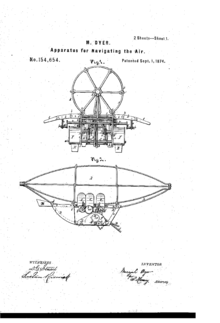
In 1874, Micajah Clark Dyer filed U.S. Patent 154,654[53][54] "Apparatus for Navigating the Air". It is believed successful trial flights were made between 1872–1874, but detailed dates are not available.[55] The apparatus used a combination of wings and paddle wheels for navigation and propulsion.
In operating the machinery the wings receive an upward and downward motion, in the manner of the wings of a bird, the outer ends yielding as they are raised, but opening out and then remaining rigid while being depressed. The wings, if desired, may be set at an angle so as to propel forward as well as to raise the machine in the air. The paddle-wheels are intended to be used for propelling the machine, in the same way that a vessel is propelled in water. An instrument answering to a rudder is attached for guiding the machine. A balloon is to be used for elevating the flying ship, after which it is to be guided and controlled at the pleasure of its occupants.[56]
More details can be found in the book about his life.[57]
In 1883, the first electric-powered flight was made by Gaston Tissandier, who fitted a 1.5 hp (1.1 kW) Siemens electric motor to an airship.
The first fully controllable free flight was made in 1884 by Charles Renard and Arthur Constantin Krebs in the French Army airship La France. La France made the first flight of an airship that landed where it took off; the 170 ft (52 m) long, 66,000 cu ft (1,900 m3) airship covered 8 km (5.0 mi) in 23 minutes with the aid of an 8.5 hp (6.3 kW) electric motor,[58] and a 435 kg (959 lb) battery. It made seven flights in 1884 and 1885.[52]
In 1888, the design of the Campbell Air Ship, designed by Professor Peter C. Campbell, was submitted to aeronautic engineer Carl Edgar Myers for examination.[59] After his approval it was built by the Novelty Air Ship Company. It was lost at sea in 1889 while being flown by Professor Hogan during an exhibition flight.[60]
From 1888 to 1897, Friedrich Wölfert built three airships powered by Daimler Motoren Gesellschaft-built petrol engines, the last of which caught fire in flight and killed both occupants in 1897.[61] The 1888 version used a 2 hp (1.5 kW) single cylinder Daimler engine and flew 10 km (6 mi) from Canstatt to Kornwestheim.[62][63]
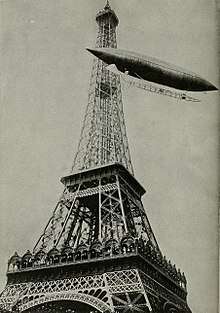
In 1897, an airship with an aluminum envelope was built by the Hungarian-Croatian engineer David Schwarz. It made its first flight at Tempelhof field in Berlin after Schwarz had died. His widow, Melanie Schwarz, was paid 15,000 marks by Count Ferdinand von Zeppelin to release the industrialist Carl Berg from his exclusive contract to supply Schwartz with aluminium.[64]
From 1897 to 1899, Konstantin Danilewsky, medical doctor and inventor from Kharkiv (now Ukraine, then Russian Empire), built four muscle-powered airships, of gas volume 150–180 m3 (5,300–6,400 cu ft). About 200 ascents were made within a framework of experimental flight program, at two locations, with no significant incidents [65][66]
Early 20th century
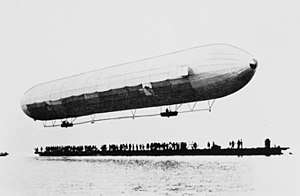
In July 1900, the Luftschiff Zeppelin LZ1 made its first flight. This led to the most successful airships of all time: the Zeppelins, named after Count von Zeppelin who began working on rigid airship designs in the 1890s, leading to the flawed LZ1 in 1900 and the more successful LZ2 in 1906. The Zeppelin airships had a framework composed of triangular lattice girders covered with fabric that contained separate gas cells. At first multiplane tail surfaces were used for control and stability: later designs had simpler cruciform tail surfaces. The engines and crew were accommodated in "gondolas" hung beneath the hull driving propellers attached to the sides of the frame by means of long drive shafts. Additionally, there was a passenger compartment (later a bomb bay) located halfway between the two engine compartments.
Alberto Santos-Dumont was a wealthy Brazilian who lived in France and had a passion for flying. He designed 18 balloons and dirigibles before turning his attention to fixed-winged aircraft.[67] On 19 October 1901 he flew his airship Number 6, from the Parc Saint Cloud to and around the Eiffel Tower and back in under thirty minutes.[68] This feat earned him the Deutsch de la Meurthe prize of 100,000 francs. Many inventors were inspired by Santos-Dumont's small airships . Many airship pioneers, such as the American Thomas Scott Baldwin, financed their activities through passenger flights and public demonstration flights. Stanley Spencer built the first British airship with funds from advertising baby food on the sides of the envelope.[69] Others, such as Walter Wellman and Melvin Vaniman, set their sights on loftier goals, attempting two polar flights in 1907 and 1909, and two trans-Atlantic flights in 1910 and 1912.[70]
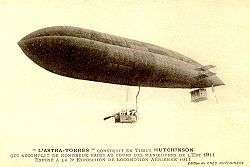
In 1902 the Spanish engineer Leonardo Torres Quevedo published details of an innovative airship design in Spain and France. With a non-rigid body and internal bracing wires, it overcame the flaws of these types of aircraft as regards both rigid structure (zeppelin type) and flexibility, providing the airships with more stability during flight, and the capability of using heavier engines and a greater passenger load. In 1905, helped by Captain A. Kindelán, he built the airship "España" at the Guadalajara military base. Next year he patented his design without attracting official interest. In 1909 he patented an improved design that he offered to the French Astra company, who started mass-producing it in 1911 as the Astra-Torres airship. The distinctive three-lobed design was widely used during the Great War by the Entente powers.
Other airship builders were also active before the war: from 1902 the French company Lebaudy Frères specialized in semirigid airships such as the Patrie and the République, designed by their engineer Henri Julliot, who later worked for the American company Goodrich; the German firm Schütte-Lanz built the wooden-framed SL series from 1911, introducing important technical innovations; another German firm Luft-Fahrzeug-Gesellschaft built the Parseval-Luftschiff (PL) series from 1909,[71] and Italian Enrico Forlanini's firm had built and flown the first two Forlanini airships.[72]
On May 12, 1902, the inventor and Brazilian aeronaut Augusto Severo de Albuquerque Maranhao and his French mechanic, Georges Saché, died when they were flying over Paris in the airship called Pax. A marble plaque at number 81 of the Avenue du Maine in Paris, commemorates the location of Augusto Severo accident.[73][74] The Catastrophe of the Balloon "Le Pax" is a 1902 short silent film recreation of the catastrophe, directed by Georges Méliès.
In Britain, the Army built their first dirigible, the Nulli Secundus, in 1907. The Navy ordered the construction of an experimental rigid in 1908. Officially known as His Majesty's Airship No. 1 and nicknamed the Mayfly, it broke its back in 1911 before making a single flight. Work on a successor did not start until 1913.
In 1910 Walter Wellman unsuccessfully attempted an aerial crossing of the Atlantic Ocean in the airship America.
World War I

The prospect of airships as bombers had been recognized in Europe well before the airships were up to the task. H. G. Wells' The War in the Air (1908) described the obliteration of entire fleets and cities by airship attack. The Italian forces became the first to use dirigibles for a military purpose during the Italo–Turkish War, the first bombing mission being flown on 10 March 1912.[75] World War I marked the airship's real debut as a weapon. The Germans, French and Italians all used airships for scouting and tactical bombing roles early in the war, and all learned that the airship was too vulnerable for operations over the front. The decision to end operations in direct support of armies was made by all in 1917.[76][77]
Many in the German military believed they had found the ideal weapon with which to counteract British naval superiority and strike at Britain itself, while more realistic airship advocates believed the zeppelin's value was as a long range scout/attack craft for naval operations. Raids on England began in January 1915 and peaked in 1916: following losses to the British defenses only a few raids were made in 1917–18, the last in August 1918.[78] Zeppelins proved to be terrifying but inaccurate weapons. Navigation, target selection and bomb-aiming proved to be difficult under the best of conditions, and the cloud cover that was frequently encountered by the airships reduced accuracy even further. The physical damage done by airships over the course of the war was insignificant, and the deaths that they caused amounted to a few hundred.[79] Nevertheless, the raid caused a significant diversion of British resources to defense efforts. The airships were initially immune to attack by aircraft and anti-aircraft guns: as the pressure in their envelopes was only just higher than ambient air, holes had little effect. But following the introduction of a combination of incendiary and explosive ammunition in 1916, their flammable hydrogen lifting gas made them vulnerable to the defending aeroplanes. Several were shot down in flames by British defenders, and many others destroyed in accidents. New designs capable of reaching greater altitude were developed, but although this made them immune from attack it made their bombing accuracy even worse.
Countermeasures by the British included sound detection equipment, searchlights and anti-aircraft artillery, followed by night fighters in 1915. One tactic used early in the war, when their limited range meant the airships had to fly from forward bases and the only zeppelin production facilities were in Friedrichshafen, was the bombing of airship sheds by the British Royal Naval Air Service. Later in the war, the development of the aircraft carrier led to the first successful carrier-based air strike in history: on the morning of 19 July 1918, seven Sopwith 2F.1 Camels were launched from HMS Furious and struck the airship base at Tønder, destroying zeppelins L 54 and L 60.[80]
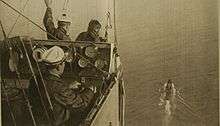
The British Army had abandoned airship development in favour of aeroplanes before the start of the war, but the Royal Navy had recognized the need for small airships to counteract the submarine and mine threat in coastal waters.[81] Beginning in February 1915, they began to develop the SS (Sea Scout) class of blimp. These had a small envelope of 1,699–1,982 m3 (60,000–70,000 cu ft) and at first used aircraft fuselages without the wing and tail surfaces as control cars. Later, more advanced blimps with purpose-built gondolas were used. The NS class (North Sea) were the largest and most effective non-rigid airships in British service, with a gas capacity of 10,200 m3 (360,000 cu ft), a crew of 10 and an endurance of 24 hours. Six 230 lb (100 kg) bombs were carried, as well as three to five machine guns. British blimps were used for scouting, mine clearance, and convoy patrol duties. During the war, the British operated over 200 non-rigid airships.[82] Several were sold to Russia, France, the United States, and Italy. The large number of trained crews, low attrition rate and constant experimentation in handling techniques meant that at the war's end Britain was the world leader in non-rigid airship technology.
The Royal Navy continued development of rigid airships until the end of the war. Eight rigid airships had been completed by the armistice, (No. 9r, four 23 Class, two R23X Class and one R31 Class), although several more were in an advanced state of completion by the war's end.[83] Both France and Italy continued to use airships throughout the war. France preferred the non-rigid type, whereas Italy flew 49 semi-rigid airships in both the scouting and bombing roles.[84]
Aeroplanes had essentially replaced airships as bombers by the end of the war, and Germany's remaining zeppelins were destroyed by their crews, scrapped or handed over to the Allied powers as war reparations. The British rigid airship program, which had mainly been a reaction to the potential threat of the German airships, was wound down.
The interwar period
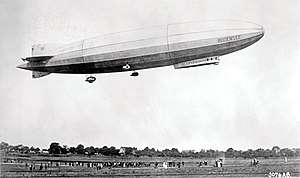
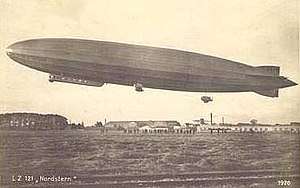
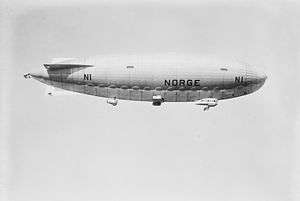
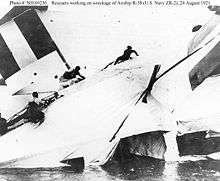
Britain, the United States and Germany built rigid airships between the two world wars. Italy and France made limited use of Zeppelins handed over as war reparations. Italy, the Soviet Union, the United States and Japan mainly operated semi-rigid airships.
Under the terms of the Treaty of Versailles, Germany was not allowed to build airships of greater capacity than a million cubic feet. Two small passenger airships, LZ 120 Bodensee and its sister ship LZ 121 Nordstern, were built immediately after the war but were confiscated following the sabotage of the wartime Zeppelins that were to have been handed over as war reparations: Bodensee was given to Italy and Nordstern to France. On May 12, 1926, the Italian semi-rigid airship Norge was the first aircraft to fly over the North Pole.
The British R33 and R34 were near-identical copies of the German L 33, which had come down almost intact in Yorkshire on 24 September 1916.[85] Despite being almost three years out of date by the time they were launched in 1919, they became two of the most successful airships in British service. The creation of the Royal Air Force (RAF) in early 1918 created a hybrid British airship program. The RAF was not interested in airships while the Admiralty was, so a deal was made where the Admiralty would design any future military airships and the RAF would handle manpower, facilities and operations.[86] On 2 July 1919, R34 began the first double crossing of the Atlantic by an aircraft. It landed at Mineola, Long Island on 6 July after 108 hours in the air; the return crossing began on 8 July and took 75 hours. This feat failed to generate enthusiasm for continued airship development, and the British airship program was rapidly wound down.
During World War One, the U.S. Navy acquired its first airship, the DH-1,[87] but it was destroyed while being inflated shortly after delivery to the Navy. After the war, the U.S. Navy contracted to buy the R 38, which was being built in Britain, but before it was handed over it was destroyed because of a structural failure during a test flight.[88]
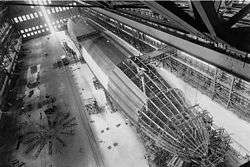
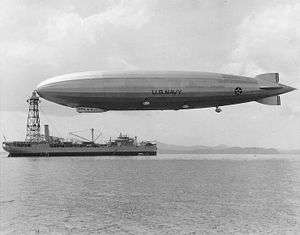
America then started constructing the USS Shenandoah, designed by the Bureau of Aeronautics and based on the Zeppelin L 49.[89] Assembled in Hangar No. 1 and first flown on 4 September 1923 at Lakehurst, New Jersey, it was the first airship to be inflated with the noble gas helium, which was then so scarce that the Shenandoah contained most of the world's supply. A second airship, USS Los Angeles, was built by the Zeppelin company as compensation for the airships that should have been handed over as war reparations according to the terms of the Versailles Treaty but had been sabotaged by their crews. This construction order saved the Zeppelin works from the threat of closure. The success of the Los Angeles, which was flown successfully for eight years, encouraged the U.S. Navy to invest in its own, larger airships. When the Los Angeles was delivered, the two airships had to share the limited supply of helium, and thus alternated operating and overhauls.[91]
In 1922 Sir Dennistoun Burney suggested a plan for a subsidised air service throughout the British Empire using airships (the Burney Scheme).[86] Following the coming to power of Ramsay MacDonald's Labour government in 1924, the scheme was transformed into the Imperial Airship Scheme, under which two airships were built, one by a private company and the other by the Royal Airship Works under Air Ministry control. The two designs were radically different. The "capitalist" ship, the R100, was more conventional, while the "socialist" ship, the R101, had many innovative design features. Construction of both took longer than expected, and the airships did not fly until 1929. Neither airship was capable of the service intended, though the R100 did complete a proving flight to Canada and back in 1930.[92] On 5 October 1930, the R101, which had not been thoroughly tested after major modifications, crashed on its maiden voyage at Beauvais in France killing 48 of the 54 people aboard. Among the dead were the craft's chief designer and the Secretary of State for Air. The disaster put an end to further British airship development.
The Locarno Treaties of 1925 lifted the restrictions on German airship construction, and the Zeppelin company started construction of the Graf Zeppelin (LZ 127), the largest airship that could be built in the company's existing shed, and intended to stimulate interest in passenger airships. The Graf Zeppelin burned blau gas, similar to propane, stored in large gas bags below the hydrogen cells, as fuel. Since its density was similar to that of air, it avoided the weight change as fuel was used, and thus the need to valve hydrogen. The Graf Zeppelin had an impressive safety record, flying over 1,600,000 km (990,000 mi) (including the first circumnavigation of the globe by airship) without a single passenger injury.[93]
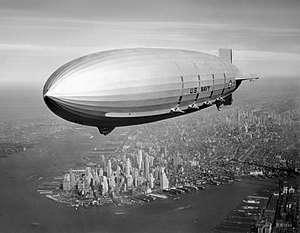
The U.S. Navy experimented with the use of airships as airborne aircraft carriers, developing an idea pioneered by the British. The USS Los Angeles was used for initial experiments, and the USS Akron and Macon, the world's largest at the time, were used to test the principle in naval operations. Each carried four F9C Sparrowhawk fighters in its hangar, and could carry a fifth on the trapeze. The idea had mixed results. By the time the Navy started to develop a sound doctrine for using the ZRS-type airships, the last of the two built, USS Macon, had been lost. The seaplane had become more capable, and was considered a better investment.[94]
Eventually, the U.S. Navy lost all three U.S.-built rigid airships to accidents. USS Shenandoah flew into a severe thunderstorm over Noble County, Ohio while on a poorly planned publicity flight on 3 September 1925. It broke into pieces, killing 14 of its crew. USS Akron was caught in a severe storm and flown into the surface of the sea off the shore of New Jersey on 3 April 1933. It carried no life boats and few life vests, so 73 of its crew of 76 died from drowning or hypothermia. USS Macon was lost after suffering a structural failure offshore near Point Sur Lighthouse on 12 February 1935. The failure caused a loss of gas, which was made much worse when the aircraft was driven over pressure height causing it to lose too much helium to maintain flight.[95] Only two of its crew of 83 died in the crash thanks to the inclusion of life jackets and inflatable rafts after the Akron disaster.
The Empire State Building was completed in 1931 with a dirigible mast, in anticipation of passenger airship service. Various entrepreneurs experimented with commuting and shipping freight via airship.[96]
In the 1930s the German Zeppelins successfully competed with other means of transport. They could carry significantly more passengers than other contemporary aircraft while providing amenities similar to those on ocean liners, such as private cabins, observation decks, and dining rooms. Less importantly, the technology was potentially more energy-efficient than heavier-than-air designs. Zeppelins were also faster than ocean liners. On the other hand, operating airships was quite involved. Often the crew would outnumber passengers, and on the ground large teams were necessary to assist mooring and very large hangars were required at airports.
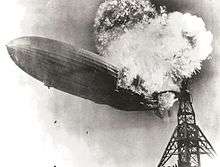
By the mid-1930s only Germany still pursued airship development. The Zeppelin company continued to operate the Graf Zeppelin on passenger service between Frankfurt and Recife in Brazil, taking 68 hours. Even with the small Graf Zeppelin, the operation was almost profitable.[97] In the mid-1930s work started to build an airship designed specifically to operate a passenger service across the Atlantic.[98] The Hindenburg (LZ 129) completed a successful 1936 season, carrying passengers between Lakehurst, New Jersey and Germany. The year 1937 started with the most spectacular and widely remembered airship accident. Approaching the Lakehurst mooring mast minutes before landing on 6 May 1937, the Hindenburg burst into flames and crashed. Of the 97 people aboard, 36 died: 13 passengers, 22 aircrew, and one American ground-crewman. The disaster happened before a large crowd, was filmed and a radio news reporter was recording the arrival. This was a disaster that theater goers could see and hear in newsreels. The Hindenburg disaster shattered public confidence in airships, and brought a definitive end to their "golden age". The day after the Hindenburg crashed, the Graf Zeppelin landed at the end of its flight from Brazil. This was the last international passenger airship flight.
Hindenburg's sister ship, the Graf Zeppelin II (LZ 130), could not carry commercial passengers without helium, which the United States refused to sell to Germany. The Graf Zeppelin made several test flights and conducted some electronic espionage until 1939 when it was grounded due to the beginning of the war. The two Graf Zeppelins were scrapped in early 1940.
Development of airships continued only in the United States, and to a smaller extent, the Soviet Union. The Soviet Union had several semi-rigid and non-rigid airships. The semi-rigid dirigible SSSR-V6 OSOAVIAKhIM was among the largest of these craft, and it set the longest endurance flight at the time of over 130 hours. It crashed into a mountain in 1938, killing 13 of the 19 people on board. While this was a severe blow to the Soviet airship program, they continued to operate non-rigid airships until 1950.
World War II
While Germany determined that airships were obsolete for military purposes in the coming war and concentrated on the development of aeroplanes, the United States pursued a program of military airship construction even though it had not developed a clear military doctrine for airship use. When the Japanese attacked Pearl Harbor on 7 December 1941, bringing the United States into World War II, the U.S. Navy had 10 nonrigid airships:
- 4 K-class: K-2, K-3, K-4 and K-5 designed as patrol ships, all built in 1938.
- 3 L-class: L-1, L-2 and L-3 as small training ships, produced in 1938.
- 1 G-class, built in 1936 for training.
- 2 TC-class that were older patrol airships designed for land forces, built in 1933. The U.S. Navy acquired both from the United States Army in 1938.
_Puritan_(2834542477).jpg)
Only K- and TC-class airships were suitable for combat and they were quickly pressed into service against Japanese and German submarines, which were then sinking American shipping within visual range of the American coast. U.S. Navy command, remembering airship's anti-submarine success in World War I, immediately requested new modern antisubmarine airships and on 2 January 1942 formed the ZP-12 patrol unit based in Lakehurst from the four K airships. The ZP-32 patrol unit was formed from two TC and two L airships a month later, based at NAS Moffett Field in Sunnyvale, California. An airship training base was created there as well. The status of submarine-hunting Goodyear airships in the early days of World War II has created significant confusion. Although various accounts refer to airships Resolute and Volunteer as operating as "privateers" under a Letter of Marque, Congress never authorized a commission, nor did the President sign one.[99]
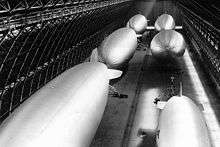
In the years 1942–44, approximately 1,400 airship pilots and 3,000 support crew members were trained in the military airship crew training program and the airship military personnel grew from 430 to 12,400. The U.S. airships were produced by the Goodyear factory in Akron, Ohio. From 1942 till 1945, 154 airships were built for the U.S. Navy (133 K-class, 10 L-class, seven G-class, four M-class) and five L-class for civilian customers (serial numbers L-4 to L-8).
The primary airship tasks were patrol and convoy escort near the American coastline. They also served as an organization centre for the convoys to direct ship movements, and were used in naval search and rescue operations. Rarer duties of the airships included aerophoto reconnaissance, naval mine-laying and mine-sweeping, parachute unit transport and deployment, cargo and personnel transportation. They were deemed quite successful in their duties with the highest combat readiness factor in the entire U.S. air force (87%).
During the war, some 532 ships without airship escort were sunk near the U.S. coast by enemy submarines. Only one ship, the tanker Persephone, of the 89,000 or so in convoys escorted by blimps was sunk by the enemy.[100] Airships engaged submarines with depth charges and, less frequently, with other on-board weapons. They were excellent at driving submarines down, where their limited speed and range prevented them from attacking convoys. The weapons available to airships were so limited that until the advent of the homing torpedo they had little chance of sinking a submarine.[101]
Only one airship was ever destroyed by U-boat: on the night of 18/19 July 1943, the K-74 from ZP-21 division was patrolling the coastline near Florida. Using radar, the airship located a surfaced German submarine. The K-74 made her attack run but the U-boat opened fire first. K-74's depth charges did not release as she crossed the U-boat and the K-74 received serious damage, losing gas pressure and an engine but landing in the water without loss of life. The crew was rescued by patrol boats in the morning, but one crewman, Aviation Machinist's Mate Second Class Isadore Stessel, died from a shark attack. The U-Boat, submarine U-134, was slightly damaged and the next day or so was attacked by aircraft, sustaining damage that forced it to return to base. It was finally sunk on 24 August 1943 by a British Vickers Wellington near Vigo, Spain.[102][103]
Fleet Airship Wing One operated from Lakehurst, New Jersey, Glynco, Georgia, Weeksville, North Carolina, South Weymouth NAS Massachusetts, Brunswick NAS and Bar Harbor Maine, Yarmouth, Nova Scotia, and Argentia, Newfoundland.

Some Navy blimps saw action in the European war theater. In 1944–45, the U.S. Navy moved an entire squadron of eight Goodyear K class blimps (K-89, K-101, K-109, K-112, K-114, K-123, K-130, & K-134) with flight and maintenance crews from Weeksville Naval Air Station in North Carolina to Naval Air Station Port Lyautey, French Morocco.[104] Their mission was to locate and destroy German U-boats in the relatively shallow waters around the Strait of Gibraltar where magnetic anomaly detection (MAD) was viable. PBY aircraft had been searching these waters but MAD required low altitude flying that was dangerous at night for these aircraft. The blimps were considered a perfect solution to establish a 24/7 MAD barrier (fence) at the Straits of Gibraltar with the PBYs flying the day shift and the blimps flying the night shift. The first two blimps (K-123 & K-130) left South Weymouth NAS on 28 May 1944 and flew to Argentia, Newfoundland, the Azores, and finally to Port Lyautey where they completed the first transatlantic crossing by nonrigid airships on 1 June 1944. The blimps of USN Blimp Squadron ZP-14 (Blimpron 14, aka The Africa Squadron) also conducted mine-spotting and mine-sweeping operations in key Mediterranean ports and various escorts including the convoy carrying United States President Franklin D. Roosevelt and British Prime Minister Winston Churchill to the Yalta Conference in 1945. Airships from the ZP-12 unit took part in the sinking of the last U-Boat before German capitulation, sinking the U-881 on 6 May 1945 together with destroyers Atherton and Mobery.
Other airships patrolled the Caribbean, Fleet Airship Wing Two, Headquartered at NAS Richmond, Florida, covered the Gulf of Mexico from Richmond and Key West, Florida, Houma, Louisiana, as well as Hitchcock and Brownsville, Texas. FAW 2 also patrolled the northern Caribbean from San Julian, the Isle of Pines (now called Isla de la Juventud) and Guantánamo Bay, Cuba as well as Vernam Field, Jamaica.
Navy blimps of Fleet Airship Wing Five, (ZP-51) operated from bases in Trinidad, British Guiana and Paramaribo, Suriname. Fleet Airship Wing Four operated along the coast of Brazil. Two squadrons, VP-41 and VP-42 flew from bases at Amapá, Igarapé-Açu, São Luís Fortaleza, Fernando de Noronha, Recife, Maceió, Ipitanga (near Salvador, Bahia), Caravelas, Vitória and the hangar built for the Graf Zeppelin at Santa Cruz, Rio de Janeiro.
Fleet Airship Wing Three operated squadrons, ZP-32 from Moffett Field, ZP-31 at NAS Santa Ana, and ZP-33 at NAS Tillamook, Oregon. Auxiliary fields were at Del Mar, Lompoc, Watsonville and Eureka, California, North Bend and Astoria, Oregon, as well as Shelton and Quillayute in Washington.
From 2 January 1942 until the end of war airship operations in the Atlantic, the blimps of the Atlantic fleet made 37,554 flights and flew 378,237 hours. Of the over 70,000 ships in convoys protected by blimps, only one was sunk by a submarine while under blimp escort.[101]
The Soviet Union flew a single airship during the war. The W-12, built in 1939, entered service in 1942 for paratrooper training and equipment transport. It made 1432 flights with 300 metric tons of cargo until 1945. On 1 February 1945, the Soviets constructed a second airship, a Pobeda-class (Victory-class) unit (used for mine-sweeping and wreckage clearing in the Black Sea) that crashed on 21 January 1947. Another W-class - W-12bis Patriot - was commissioned in 1947 and was mostly used until the mid 1950s for crew training, parades and propaganda.
Postwar period
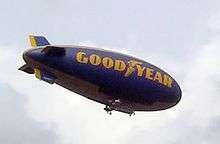
Although airships are no longer used for major cargo and passenger transport, they are still used for other purposes such as advertising, sightseeing, surveillance, research and advocacy.
In the 1980s, Per Lindstrand and his team introduced the GA-42 airship, the first airship to use fly-by-wire flight control, which considerably reduced the pilot's workload.
The world's largest thermal airship (300,000 cubic feet; 8,500 cubic metres) was constructed by the Per Lindstrand company for French botanists in 1993. The AS-300 carried an underslung raft, which was positioned by the airship on top of tree canopies in the rain forest, allowing the botanists to carry out their treetop research without significant damage to the rainforest. When research was finished at a given location, the airship returned to pick up and relocate the raft.[105]
In June 1987, the U.S. Navy awarded a US$168.9 million contract to Westinghouse Electric and Airship Industries of the UK to find out whether an airship could be used as an airborne platform to detect the threat of sea-skimming missiles, such as the Exocet.[106] At 2.5 million cubic feet, the Westinghouse/Airship Industries Sentinel 5000 (Redesignated YEZ-2A by the U. S. Navy) prototype design was to have been the largest blimp ever constructed.[107] Additional funding for the Naval Airship Program was killed in 1995 and development was discontinued.
The CA-80 airship, which was produced in 2000 by Shanghai Vantage Airship Manufacture Co., Ltd., had a successful trial flight in September 2001. This was designed for advertisement and propagation, air-photo, scientific test, tour and surveillance duties. It was certified as a grade-A Hi-Tech introduction program (No. 20000186) in Shanghai. The CAAC authority granted a type design approval and certificate of airworthiness for the airship.[108]
In the 1990s the Zeppelin company returned to the airship business. Their new model, designated the Zeppelin NT, made its maiden flight on 18 September 1997. As of 2009 there were four NT aircraft flying, a fifth was completed in March 2009 and an expanded NT-14 (14,000 cubic meters of helium, capable of carrying 19 passengers) was under construction. One was sold to a Japanese company, and was planned to be flown to Japan in the summer of 2004. Due to delays getting permission from the Russian government, the company decided to transport the airship to Japan by sea. One of the four NT craft is in South Africa carrying diamond detection equipment from De Beers, an application at which the very stable low vibration NT platform excels. The project included design adaptations for high temperature operation and desert climate, as well as a separate mooring mast and a very heavy mooring truck. NT-4 belonged to Airship Ventures of Moffett Field, Mountain View in the San Francisco Bay Area, and provided sight-seeing tours.
Blimps are used for advertising and as TV camera platforms at major sporting events. The most iconic of these are the Goodyear Blimps. Goodyear operates three blimps in the United States, and The Lightship Group, now The AirSign Airship Group,[109] operates up to 19 advertising blimps around the world. Airship Management Services owns and operates three Skyship 600 blimps. Two operate as advertising and security ships in North America and the Caribbean. Airship Ventures operated a Zeppelin NT for advertising, passenger service and special mission projects. They were the only airship operator in the U.S. authorized to fly commercial passengers, until closing their doors in 2012.
Skycruise Switzerland AG owns and operates two Skyship 600 blimps. One operates regularly over Switzerland used on sightseeing tours.
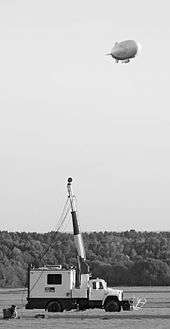
The Switzerland-based Skyship 600 has also played other roles over the years. For example, it was flown over Athens during the 2004 Summer Olympics as a security measure. In November 2006, it carried advertising calling it The Spirit of Dubai as it began a publicity tour from London to Dubai, UAE on behalf of The Palm Islands, the world's largest man-made islands created as a residential complex.
Los Angeles-based Worldwide Aeros Corp. produces FAA Type Certified Aeros 40D Sky Dragon airships.[110]
In May 2006, the U.S. Navy began to fly airships again after a hiatus of nearly 44 years. The program uses a single American Blimp Company A-170 nonrigid airship, with designation MZ-3A. Operations focus on crew training and research, and the platform integrator is Northrop Grumman. The program is directed by the Naval Air Systems Command and is being carried out at NAES Lakehurst, the original centre of U.S. Navy lighter-than-air operations in previous decades.
In November 2006 the U.S. Army bought an A380+ airship from American Blimp Corporation through a Systems level contract with Northrop Grumman and Booz Allen Hamilton. The airship started flight tests in late 2007, with a primary goal of carrying 2,500 lb (1,100 kg) of payload to an altitude of 15,000 ft (4,600 m) under remote control and autonomous waypoint navigation. The program will also demonstrate carrying 1,000 lb (450 kg) of payload to 20,000 ft (6,100 m) The platform could be used for Multi-Intelligence collections. In 2008, the CA-150 airship was launched by Vantage Airship. This is an improved modification of model CA-120 and completed manufacturing in 2008. With larger volume and increased passenger capacity, it is the largest manned nonrigid airship in China at present.[111]
An airship was prominently featured in the James Bond film A View to a Kill, released in 1985. The Skyship 500 had the livery of Zorin Industries.[112]
In late June 2014 the Electronic Frontier Foundation flew the GEFA-FLUG AS 105 GD/4[113] blimp AE Bates (owned by, and in conjunction with, Greenpeace) over the NSA's Bluffdale Utah Data Center in protest.[114]
Postwar projects
Hybrid designs such as the Heli-Stat airship/helicopter, the Aereon aerostatic/aerodynamic craft, and the CycloCrane (a hybrid aerostatic/rotorcraft), struggled to take flight. The Cyclocrane was also interesting in that the airship's envelope rotated along its longitudinal axis.
In 2005, a short-lived project of the U.S. Defense Advanced Research Projects Agency (DARPA) was Walrus HULA, which explored the potential for using airships as long-distance, heavy lift craft.[115][116] The primary goal of the research program was to determine the feasibility of building an airship capable of carrying 500 short tons (450 t) of payload a distance of 12,000 mi (19,000 km) and land on an unimproved location without the use of external ballast or ground equipment (such as masts). In 2005, two contractors, Lockheed Martin and US Aeros Airships were each awarded approximately $3 million to do feasibility studies of designs for WALRUS. Congress removed funding for Walrus HULA in 2006.[117]
Modern airships
Military airships
In 2010, the U.S. Army awarded a $517 million (£350.6 million) contract to Northrop Grumman and partner Hybrid Air Vehicles to develop a Long Endurance Multi-Intelligence Vehicle (LEMV) system, in the form of three HAV 304s.[118][119][120] The project was cancelled in February 2012 due to it being behind schedule and over budget; also the forthcoming U.S. withdrawal from Afghanistan where it was intended to be deployed.[121] Following this the Hybrid Air Vehicles HAV 304 Airlander 10 was repurchased by Hybrid Air Vehicles then modified and reassembled in Bedford, UK, and renamed the Airlander 10.[122] It is currently being tested in readiness for its UK flight test programme.[123]
A-NSE, a French company, manufactures and operates airships and aerostats. For 2 years, A-NSE has been testing its airships for the French Army. Airships and aerostats are operated to provide intelligence, surveillance, and reconnaissance (ISR) support. Their airships include many innovative features such as water ballast take-off and landing systems, variable geometry envelopes and thrust–vectoring systems.
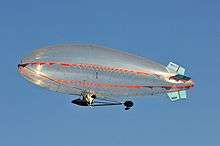
The U.S. government has funded two major projects in the high altitude arena. The Composite Hull High Altitude Powered Platform (CHHAPP) is sponsored by U.S. Army Space and Missile Defense Command. This aircraft is also sometimes called HiSentinel High-Altitude Airship. This prototype ship made a five-hour test flight in September 2005. The second project, the high-altitude airship (HAA), is sponsored by DARPA. In 2005, DARPA awarded a contract for nearly $150 million to Lockheed Martin for prototype development. First flight of the HAA was planned for 2008 but suffered programmatic and funding delays. The HAA project evolved into the High Altitude Long Endurance-Demonstrator (HALE-D). The U.S. Army and Lockheed Martin launched the first-of-its kind HALE-D on July 27, 2011.[125] After attaining an altitude of 32,000 ft (9,800 m), due to an anomaly, the company decided to abort the mission. The airship made a controlled descent in an unpopulated area of southwest Pennsylvania.[126][127][128]
On 31 January 2006 Lockheed Martin made the first flight of their secretly built hybrid airship designated the P-791. The design is very similar to the SkyCat, unsuccessfully promoted for many years by the British company Advanced Technologies Group (ATG).
Dirigibles have been used in the War in Afghanistan for reconnaissance purposes, as they allow for constant monitoring of a specific area through cameras mounted on the airships.[129]
Passenger transport

In the 1990s, the successor of the original Zeppelin company in Friedrichshafen, the Zeppelin Luftschifftechnik GmbH, reengaged in airship construction. The first experimental craft (later christened Friedrichshafen) of the type "Zeppelin NT" flew in September 1997. Though larger than common blimps, the Neue Technologie (New Technology) zeppelins are much smaller than their giant ancestors and not actually Zeppelin-types in the classical sense. They are sophisticated semirigids. Apart from the greater payload, their main advantages compared to blimps are higher speed and excellent maneuverability. Meanwhile, several Zeppelin NT have been produced and operated profitably in joyrides, research flights and similar applications.
In June 2004, a Zeppelin NT was sold for the first time to a Japanese company, Nippon Airship Corporation, for tourism and advertising mainly around Tokyo. It was also given a role at the 2005 Expo in Aichi. The aircraft began a flight from Friedrichshafen to Japan, stopping at Geneva, Paris, Rotterdam, Munich, Berlin, Stockholm and other European cities to carry passengers on short legs of the flight. Russian authorities denied overflight permission, so the airship had to be dismantled and shipped to Japan rather than following the historic Graf Zeppelin flight from Germany to Japan.
In 2008, Airship Ventures Inc. began operations from Moffett Federal Airfield near Mountain View, California and until November 2012 offered tours of the San Francisco Bay Area for up to 12 passengers.
Exploration
In November 2005, De Beers, a diamond mining company, launched an airship exploration program over the remote Kalahari desert. A Zeppelin NT, equipped with a Bell Geospace gravity gradiometer, was used to find potential diamond mines by scanning the local geography for low-density rock formations, known as kimberlite pipes. On 21 September 2007, the airship was severely damaged by a whirlwind while in Botswana. One crew member, who was on watch aboard the moored craft, was slightly injured but released after overnight observation in hospital.
Thermal airships
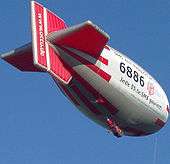
Several companies, such as Cameron Balloons in Bristol, United Kingdom, build hot-air airships. These combine the structures of both hot-air balloons and small airships. The envelope is the normal cigar shape, complete with tail fins, but is inflated with hot air instead of helium to provide the lifting force. A small gondola, carrying the pilot and passengers, a small engine, and the burners to provide the hot air are suspended below the envelope, beneath an opening through which the burners protrude.
Hot-air airships typically cost less to buy and maintain than modern helium-based blimps, and can be quickly deflated after flights. This makes them easy to carry in trailers or trucks and inexpensive to store. They are usually very slow moving, with a typical top speed of 25–30 km/h (15–20 mph, 6.7–8.9 m/s). They are mainly used for advertising, but at least one has been used in rainforests for wildlife observation, as they can be easily transported to remote areas.
Unmanned remotes
Remote-controlled (RC) airships, a type of unmanned aerial system (UAS), are sometimes used for commercial purposes such as advertising and aerial video and photography as well as recreational purposes. They are particularly common as an advertising mechanism at indoor stadiums. While RC airships are sometimes flown outdoors, doing so for commercial purposes is illegal in the US.[130] Commercial use of an unmanned airship must be certified under part 121.
Current design projects

Today, with large, fast, and more cost-efficient fixed-wing aircraft and helicopters, it is unknown whether huge airships can operate profitably in regular passenger transport though, as energy costs rise, attention is once again returning to these lighter-than-air vessels as a possible alternative. At the very least, the idea of comparatively slow, "majestic" cruising at relatively low altitudes and in comfortable atmosphere certainly has retained some appeal. There have been some niches for airships in and after World War II, such as long-duration observations, antisubmarine patrol, platforms for TV camera crews, and advertising; these generally require only small and flexible craft, and have thus generally been better fitted for cheaper (non-passenger) blimps.
Heavy lifting
It has periodically been suggested that airships could be employed for cargo transport, especially delivering extremely heavy loads to areas with poor infrastructure over great distances. This has also been called roadless trucking.[131] Also, airships could be used for heavy lifting over short distances (e.g. on construction sites); this is described as heavy-lift, short-haul.[132] In both cases, the airships are heavy haulers. One recent enterprise of this sort was the Cargolifter project, in which a hybrid (thus not entirely Zeppelin-type) airship even larger than Hindenburg was projected. Around 2000, CargoLifter AG built the world's largest self-supporting hall, measuring 360 m (1,180 ft) long, 210 m (690 ft) wide and 107 m (351 ft) high about 60 km (37 mi) south of Berlin. In May 2002, the project was stopped for financial reasons; the company had to file bankruptcy. The enormous CargoLifter hangar was later converted to house the Tropical Islands Resort.[133] Although no rigid airships are currently used for heavy lifting, hybrid airships are being developed for such purposes. AEREON 26, tested in 1971, was described in John McPhee's The Deltoid Pumpkin Seed.
An impediment to the large-scale development of airships as heavy haulers has been figuring out how they can be used in a cost-efficient way. In order to have a significant economic advantage over ocean transport, cargo airships must be able to deliver their payload faster than ocean carriers but more cheaply than airplanes. William Crowder, a fellow at the Logistics Management Institute, has calculated that cargo airships are only economical when they can transport 500 to 1,000 tons, approximately the same as a super-jumbo aircraft.[133] The large initial investment required to build such a large airship has been a hindrance to production, especially given the risk inherent in a new technology. The chief commercial officer of the company hoping to sell the LMH-1, a cargo airship currently being developed by Lockheed Martin, believes that airships can be economical in hard-to-reach locations such as mining operations in northern Canada that currently require ice roads.[133]
Metal-clad airships
A metal-clad airship has a very thin metal envelope, rather than the usual fabric. The shell may be either internally braced or monocoque as in the ZMC-2, which flew many times in the 1920s, the only example ever to do so. The shell may be gas-tight as in a non-rigid blimp, or the design may employ internal gas bags as in a rigid airship. Compared to a fabric envelope the metal cladding is expected to be more durable.
Hybrid airships
A hybrid airship is a general term for an aircraft that combines characteristics of heavier-than-air (aeroplane or helicopter) and lighter-than-air technology. Examples include helicopter/airship hybrids intended for heavy lift applications and dynamic lift airships intended for long-range cruising. Most airships, when fully loaded with cargo and fuel, are usually ballasted to be heavier than air, and thus must use their propulsion system and shape to create aerodynamic lift, necessary to stay aloft. All airships can be operated to be slightly heavier than air at periods during flight (descent). Accordingly, the term "hybrid airship" refers to craft that obtain a significant portion of their lift from aerodynamic lift or other kinetic means.
For example, the Aeroscraft is a buoyancy assisted air vehicle that generates lift through a combination of aerodynamics, thrust vectoring and gas buoyancy generation and management, and for much of the time will fly heavier than air. Aeroscraft is Worldwide Aeros Corporation's continuation of DARPA's now cancelled Walrus HULA (Hybrid Ultra Large Aircraft) project.[134]
The Patroller P3 hybrid airship developed by Advanced Hybrid Aircraft Ltd, BC, Canada, is a relatively small (85,000 feet3 = 2,400 m3) buoyant craft, manned by the crew of 5 and with the endurance of up to 72 hours. The flight-tests with the 40% RC scale model proved that such a craft can be launched and landed without a large team of strong ground-handlers.[135] Design features a special “winglet” for aerodynamic lift control.[136]
Airships in space exploration
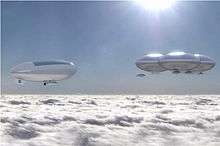
Airships have been proposed as a potential cheap alternative to surface rocket launches for achieving Earth orbit. JP Aerospace have proposed the Airship to Orbit project, which intends to float a multi-stage airship up to mesospheric altitudes of 55 km (180,000 ft) and then use ion propulsion to accelerate to orbital speed.[137] At these heights, air resistance would not be a significant problem for achieving such speeds. The company has not yet built any of the three stages.
NASA have proposed the High Altitude Venus Operational Concept, which comprises a series of five missions including manned missions to the atmosphere of Venus in airships.[138][139][140][141] Pressures on the surface of the planet are too high for human habitation, but at a specific altitude the pressure is equal to that found on Earth and this makes Venus a potential target for human colonization.
Hypothetically, there could be an airship lifted by a vacuum—that is, by material that can contain nothing at all inside but withstand the atmospheric pressure from the outside. It is, at this point, science fiction, although NASA has posited that some kind of vacuum airship could eventually be used to explore the surface of Mars.[142]
Comparison with heavier-than-air aircraft
The advantage of airships over aeroplanes is that static lift sufficient for flight is generated by the lifting gas and requires no engine power. This was an immense advantage before the middle of World War I and remained an advantage for long-distance or long-duration operations until World War II. Modern concepts for high-altitude airships include photovoltaic cells to reduce the need to land to refuel, thus they can remain in the air until consumables expire. This similarly reduces or eliminates the need to consider variable fuel weight in buoyancy calculations.
The disadvantages are that an airship has a very large reference area and comparatively large drag coefficient, thus a larger drag force compared to that of aeroplanes and even helicopters. Given the large frontal area and wetted surface of an airship, a practical limit is reached around 130–160 kilometres per hour (80–100 mph). Thus airships are used where speed is not critical.
The lift capability of an airship is equal to the buoyant force minus the weight of the airship. This assumes standard air-temperature and pressure conditions. Corrections are usually made for water vapor and impurity of lifting gas, as well as percentage of inflation of the gas cells at liftoff.[143] Based on specific lift (lifting force per unit volume of gas), the greatest static lift is provided by hydrogen (11.15 N/m3 or 71 lbf/1000 cu ft) with helium (10.37 N/m3 or 66 lbf/1000 cu ft) a close second.[144]
In addition to static lift, an airship can obtain a certain amount of dynamic lift from its engines. Dynamic lift in past airships has been about 10% of the static lift. Dynamic lift allows an airship to "take off heavy" from a runway similar to fixed-wing and rotary-wing aircraft. This requires additional weight in engines, fuel, and landing gear, negating some of the static lift capacity.
The altitude at which an airship can fly largely depends on how much lifting gas it can lose due to expansion before stasis is reached. The ultimate altitude record for a rigid airship was set in 1917 by the L-55 under the command of Hans-Kurt Flemming when he forced the airship to 7,300 m (24,000 ft) attempting to cross France after the "Silent Raid" on London. The L-55 lost lift during the descent to lower altitudes over Germany and crashed due to loss of lift.[145] While such waste of gas was necessary for the survival of airships in the later years of World War I, it was impractical for commercial operations, or operations of helium-filled military airships. The highest flight made by a hydrogen-filled passenger airship was 1,700 m (5,500 ft) on the Graf Zeppelin's around-the-world flight.[146]
The greatest disadvantage of the airship is size, which is essential to increasing performance. As size increases, the problems of ground handling increase geometrically.[147] As the German Navy changed from the P class of 1915 with a volume of over 31,000 m3 (1,100,000 cu ft) to the larger Q class of 1916, the R class of 1917, and finally the W class of 1918, at almost 62,000 m3 (2,200,000 cu ft) ground handling problems reduced the number of days the Zeppelins were able to make patrol flights. This availability declined from 34% in 1915, to 24.3% in 1916 and finally 17.5% in 1918.[148]
So long as the power-to-weight ratios of aircraft engines remained low and specific fuel consumption high, the airship had an edge for long-range or -duration operations. As those figures changed, the balance shifted rapidly in the aeroplane's favour. By mid-1917, the airship could no longer survive in a combat situation where the threat was aeroplanes. By the late 1930s, the airship barely had an advantage over the aeroplane on intercontinental over-water flights, and that advantage had vanished by the end of World War II.
This is in face-to-face tactical situations. Currently, a high-altitude airship project is planned to survey hundreds of kilometres as their operation radius, often much farther than the normal engagement range of a military aeroplane. For example, a radar mounted on a vessel platform 30 m (100 ft) high has radio horizon at 20 km (12 mi) range, while a radar at 18,000 m (59,000 ft) altitude has radio horizon at 480 km (300 mi) range. This is significantly important for detecting low-flying cruise missiles or fighter-bombers.
Safety
The most commonly used lifting gas, helium, is inert and therefore presents no fire risk.[149] A series of vulnerability tests were done by the UK Defence Evaluation and Research Agency DERA on a Skyship 600. Since the internal gas pressure was maintained at only 1–2% above the surrounding air pressure, the vehicle proved highly tolerant to physical damage or to attack by small-arms fire or missiles. Several hundred high-velocity bullets were fired through the hull, and even two hours later the vehicle would have been able to return to base. Ordnance passed through the envelope without causing critical helium loss. In all instances of light armament fire evaluated under both test and live conditions, the airship was able to complete its mission and return to base.[150]
See also
- Airborne aircraft carrier
- Aircruise
- Airship hangar
- Barrage balloon
- Evolutionary Air and Space Global Laser Engagement
- High-altitude platform station
- Hyperion, fictional airship type.
- List of airship accidents
- List of British airships
- List of current airships in the United States
- List of Zeppelins
- Mystery airship
- Stratellite
- SVAM CA-80
- Worldwide Aeros Corp
- Zeppelin mail
Notes
- A few airships after World War II used hydrogen. The first British airship to use helium was the Chitty Bang Bang of 1967.
References
Citations
- "Definition of AIRSHIP". merriam-webster.com. Retrieved 4 October 2016.
- "Discovery of Helium in Natural Gas at the University of Kansas". National Historic Chemical Landmarks. American Chemical Society. Retrieved 2014-02-21.
- Ege (1973).
- Mowthorpe, C. E. S. Battlebags, British Airships of the First World War, Phoenix Mill, United Kingdom. Alan Sutton Publishing, 1995, p. xx. ISBN 0-7509-0989-7
- "Online Etymology Dictionary". www.etymonline.com. Retrieved 2016-09-04.
- US patent 467069 "Air-ship" referring to a compound aerostat/rotorcraft.
- Ezekiel Airship (1902) wright-brothers.orgaltereddimensions.net "airship,"- referring to an HTA aeroplane.
- The Bridgeport Herald, August 18, 1901 Archived August 3, 2013, at the Wayback Machine - "air ship" referring to Whitehead's aeroplane.
- Cooley Airship of 1910, also called the Cooley monoplane."Archived copy". Archived from the original on 2012-04-02. Retrieved 2011-09-07.CS1 maint: archived copy as title (link)- a heavier-than-air monoplane.
- Frater, A.; The Balloon Factory, Picador (2009), Page 163. - Wright brothers' "airship."
- George Griffith, The angel of the Revolution, 1893 Archived 2014-02-22 at the Wayback Machine - "air-ship," "vessel" referring to a VTOL compound rotorcraft (not clear from the reference if it might be an aerostat hybrid.)
- Auckland Star, 24 February 1919 "Ships of the air," "Air yachts" - passenger landplanes large and small
- The Sydney Morning Herald, Monday 11 April 1938 -"ship of the airs," "flying-ship," referring to a large flying-boat.
- Smithsonian, America by air "Ships of the Air" referring to Pan Am's Boeing Clipper flying-boat fleet.
- Liao, L., & Pasternak, I. (2009). A review of airship structural research and development. Progress in Aerospace Sciences, 45(4), 83–96.
- Tuckerman, L. B. (1926). Inertia factors of ellipsoids for use in airship design.
- "Home : Oxford English Dictionary". Retrieved 2018-01-18.
- Ince, A. Nejat; Topuz, Ercan; Panayirci, Erdal (1998). Principles of Integrated Maritime Surveillance Systems. New York: Springer Science + Business Media, LLC. pp. 204. ISBN 9781461374046.
- Brewin, Bob. "Giant Aerostats Developed For Rural Cell Phone Service". Computerworld. Retrieved 2018-08-29.
- Ryan, Michael; Frater, Michael (2002). Tactical Communications for the Digitized Battlefield. Boston, MA: Artech House. pp. 315. ISBN 9781580533232.
- Handwerk, Brian (2013-06-18). "Google's Loon Project Puts Balloon Technology in Spotlight". Retrieved 2018-08-29.
- El-Sayed, Ahmed F. (2016-05-25). Fundamentals of Aircraft and Rocket Propulsion. Springer. ISBN 9781447167969.
- Wragg, D,; Historical Dictionary of Aviation, History Press (2008) Page 27.
- De Syon, G. (2001). Zeppelin!: Germany and the airship, 1900–1939. JHU Press.
- Hartcup, G. (1974). The achievement of the airship: a history of the development of rigid, semi-rigid, and non-rigid airships. David & Charles.
- Buerge, B. T. (2009). The Suitability of Hybrid vs. Conventional Airships for Persistent Surveillance Missions. Unpublished report from Dr. Charles Perkins. "Archived copy" (PDF). Archived from the original (PDF) on 2016-09-24. Retrieved 2016-09-24.CS1 maint: archived copy as title (link)
- "Prentice, B. E., Beilock, R. E., Phillips, A. J., & Thomson, J. (2010, October). The rebirth of airships. In Journal of the Transportation Research Forum (Vol. 44, No. 1)".
- "Khoury, G. A. (2012). Airship technology (Vol. 10). Cambridge University Press" (PDF). Archived from the original (PDF) on 2016-09-24. Retrieved 2016-09-24.
- Von Karman, Theodor. "Calculation of pressure distribution on airship hulls." (1930).
- Dooley, A.185-A.186 citing Robinson, pp.2–3 collapsed on inflation
- Dooley, A.193 (at Tempelhof, Berlin in 1897, landed but then collapsed)
- NAS Grosse Ile Archived 2011-07-09 at the Wayback Machine, NASGIVM. 2006.
- National Air and Space Museum, Smithsonian Institution. 2008. Slate Aircraft Corporation City of Glendale Negatives, Accession number 2006-0039
- City of Glendale. Photo Album. Retrieved 3 September 2008. Archived 28 May 2014 at the Wayback Machine
- "Jane's All the World's Aircraft 1980–81", Pages 609–610
- Brew, Alec (1998). Sunbeam Aero-engines. Airlife. pp. 41, 43, 92. ISBN 1-84037-023-8.CS1 maint: ref=harv (link)
- Colozza, A., & Dolce, J. (2003). Initial feasibility assessment of a high altitude long endurance airship.
- "Miller, G. D., Stoia, T. R., Harmala, D. A., & Atreya, S. (2005). Operational capability of high altitude solar powered airships. AIAA Paper, 7487".
- "Solar-powered Future: Airships are making a comeback". Big Think. 2019-10-16. Retrieved 2019-12-08.
- Hunt, Julian David; Byers, Edward; Balogun, Abdul-Lateef; Leal Filho, Walter; Colling, Angeli Viviani; Nascimento, Andreas; Wada, Yoshihide (2019-09-01). "Using the jet stream for sustainable airship and balloon transportation of cargo and hydrogen". Energy Conversion and Management: X. 3: 100016. doi:10.1016/j.ecmx.2019.100016. ISSN 2590-1745.
- "Airfreight must embrace dirigibles, says IATA". Air Cargo News. 2010-03-31. Retrieved 2019-12-08.
- "Filling the Friendly Skies With Hot Air". www.bloomberg.com. Retrieved 2019-12-08.
- "Francesco Lana-Terzi, S.J. (1631–1687); The Father of Aeronautics". Retrieved 24 July 2010.
- "Would a balloon filled with vacuum instead of helium float?". Retrieved 24 July 2010.
- Winter & Degner (1933), pp. 26–27.
- "AIRSHIP HONOURS FOR AUSTRALIA. - BLAND'S REMARKABLE INVENTION MORE THAN 70 YEARS AGO. - The Argus (Melbourne, Vic. : 1848 - 1957) - 13 Sep 1924". nla.gov.au. Retrieved 4 October 2016.
- "Visions of a flying machine - National - smh.com.au". smh.com.au. Retrieved 4 October 2016.
- Winter & Degner (1933), p. 36.
- Glazer, Stephen D. "Rutgers in the Civil War," Journal of the Rutgers University Libraries Vol. 66 (2014), page 102
- Brooks 1992 p. 19.
- Winter & Degner (1933), p. 44.
- Bento S. Mattos, Short History of Brazilian Aeronautics Archived 2013-07-26 at the Wayback Machine (PDF), 44th AIAA Aerospace Sciences Meeting and Exhibit, Reno, Nevada, 9–12 January 2006.
- "Patent Images". uspto.gov. Retrieved 4 October 2016.
- "Micajah dyee". google.com. Retrieved 4 October 2016.
- "Georgia: First in Flight?". therevivalist.info. Retrieved 4 October 2016.
- July 31, 1875 article in the Gainesville (Georgia) Eagle
- "Georgia's Pioneer Aviator, Micajah Clark Dyer - From A Leading Self Publishing Company". yourbook.com. Retrieved 4 October 2016.
- Winter & Degner (1933), pp. 49–50.
- "Aerial Navigation". The Brooklyn Daily Eagle (p. 1). Brooklyn, New York. May 23, 1888.
- Scientific American - 27 July 1889 Archived May 12, 2011, at the Wayback Machine
- Brooks 1992 p. 20.
- Mercedes-Benz Museum (Trip II): The beginning, gminsidenews.com, 2007.
- Member's Circular Letter February 2008, Archived February 27, 2012, at the Wayback Machine zeppelin-tourismus.de.
- Brooks 1992 pp. 27–31.
- Bill Welker. Airships of Konstantin Danilewsky. Then-and-Now project, publication January 2018
- (2019) AirBike...1897. Ed. by A. B. Akimov and W. J. Welker. Sapphire Publications, US, 342 p. ISBN 978-1-62374-015-3 (Digital edition) Free download. Late 1800s work of Dr. Konstantin Dalilewsky to solve the problem of human flight presented for the first time in English. Including reproduction of the original Russian and German 1900 editions.
- Niccoli, R. The Book of Flight: From the flying machines of Leonardo da Vinci to the conquest of space, New York, Friedman/Fairfax, 2002, p. 24. ISBN 978-1-58663-716-3
- Toland (1957), pp. 25–37.
- Papers Past - Christchurch Star, 31 December 1903, WAYS OF AIRSHIPS (p. 2)
- Toland (1957), pp. 49–51.
- Lueger 1920, pp.404–412, Luftschiff
- Ligugnana, Sandro
- "Death of the aeronaut Auguste Severo and his mechanic George Sache". lookandlearn.com. Retrieved 4 October 2016.
- "La belle époque. 1890–1905". e-monsite.com. Retrieved 4 October 2016.
- With the Dirigibles at TripoliFlight 30 March 1912
- Ventry & Koesnik (1982), p. 85.
- Robinson (1973), pp. 126–127.
- Robinson 1994, p. 360.
- Cole, Christopher and Cheesman, E. F. The Air Defence of Great Britain 1914–1918. London: Putnam, 1984. ISBN 0-370-30538-8. p.449
- Robinson (1994), pp. 340–341.
- Higham (1961), p. 111.
- Mowthorpe, Ces, Battlebags, Stroud, Gloucs, Allan Sutton Publishing, 1995, p. xxiii.
- Patrick Abbott and Nick Walmsley, British Airships in Pictures: An Illustrated History, House of Lochar 1998, ISBN 1-899863-48-6 (pp.59–69)
- Ventry & Koesnik (1982), p. 97.
- Higham (1961), p. 138.
- Higham (1961), p. 176.
- Magazines, Hearst (4 October 2016). "Popular Mechanics". Hearst Magazines. Retrieved 4 October 2016 – via Google Books.
- Higham 1961, pp. 222–223.
- Swanborough, G. and Bowyers, P. M. United States Navy Aircraft Since 1912. London: Putnam, 1976 (2nd ed.) ISBN 0851778380, p. 586
- Althoff, William F., USS Los Angeles, Washington DC, Brassey's, 2004, p. 48, ISBN 1-57488-620-7
- Countryman, Barry, R100 in Canada, Erin, Ontario, Boston Mills, 1982, ISBN 0-919822-36-3
- Botting, Douglas, Dr. Eckener's Dream Machine. New York: Henry Hold, 2001. ISBN 0-8050-6458-3
- Smith (1965), pp. 171–174.
- Smith (1965), pp. 157–161.
- "Intercity Dirigible Service". 2010-02-26. Cite journal requires
|journal=(help) - Botting, Douglas, Dr. Eckener's Dream Machine. New York, Henry Hold, 2001, p. 235, ISBN 0-8050-6458-3
- Dick, Harold G., with Robinson, Douglas H., Graf Zeppelin & Hindenburg, Washington DC, Smithsonian Institution Press, 1985, p. 83, ISBN 0-87474-364-8
- Theodore Richard, Reconsidering the Letter of Marque: Utilizing Private Security Providers Against Piracy (April 1, 2010). Public Contract Law Journal, Vol. 39, No. 3, pp. 411–464 at 429 n.121, Spring 2010. Available at SSRN
- Vaeth, J. Gordon, Blimps & U-Boats, Annapolis, MD, U.S. Naval Institute Press, 1992, pp. 20–21, ISBN 1-55750-876-3
- Vaeth, J. Gordon, Blimps & U-Boats, Annapolis, MD, U.S. Naval Institute Press, 1992, ISBN 1-55750-876-3
- U.S. Navy LTA history.
- U-134 history, Uboat.net.
- "Archived copy" (PDF). Archived from the original (PDF) on 2015-02-17. Retrieved 2013-06-19.CS1 maint: archived copy as title (link)
- Thermal Airships Archived October 3, 2013, at the Wayback Machine, Lindstrand Technologies.
- "Navy Awards Blimp Order". The New York Times. Reuters. 6 June 1987. Archived from the original on 15 December 2007. Retrieved 6 November 2007..
- "All the World's Aircraft 1992–93". Jane. 1992. Cite journal requires
|journal=(help). - "CA-80 Blimp". Vantage Ship. 2000. Archived from the original on 2016-03-03. Cite journal requires
|journal=(help). - "Aerial Advertising & Airplane Banner Towing - AirSign". www.airsign.com.
- "Worldwide Aeros Corp"..
- "CA-150 Blimp". Vantage Ship. 2008. Archived from the original on 2008-02-26. Cite journal requires
|journal=(help). - "IMDb"..
- "Protesters Launch a 135-Foot Blimp Over the NSA's Utah Data Center - Slashdot". slashdot.org. Retrieved 4 October 2016.
- Greenberg, Andy. "Protestors Launch a 135-Foot Blimp Over the NSA's Utah Data Center". wired.com. Retrieved 4 October 2016.
- "Contractors for Walrus Program announced" Archived 2016-02-06 at the Wayback Machine, press release, Defense Advanced Research Projects Agency, 26 August 2005.
- "US CBO Gives OK to HULA Airships for Airlift", Defense Industry Daily, 21 October 2005.
- WALRUS Hunted to Extinction By Congress, DARPA?, Defense Industry Daily, 4 April 2006
- "The Difference Engine: Not all hot air"", The Economist, July 29th 2010
- "Photo Release — Northrop Grumman Awarded $517 Million Agreement for US Army Airship With Unblinking Eye" Archived June 23, 2010, at the Wayback Machine, Northrup Grumman, June 14, 2010, access date July 29, 2010
- "250-Foot Long Hybrid Airship Will Spy Over Afghanistan Battlefields in 2011". Gizmodo. 2009-09-23. Archived from the original on 2010-11-11. Retrieved 2010-07-29.
- InsideDefense.com - February 13, 2013: Army Deflates LEMV Airship; Cost And Schedule Cited Archived March 20, 2013, at the Wayback Machine
- "Massive new AIRSHIP to enter commercial service at British dirigible base".
- "Longest aircraft in crash repair tests". 4 February 2017 – via www.bbc.co.uk.
- "Vers un retour du dirigeable pour les missions de surveillance maritime ?" (in French). Mer et Marine. 2011-10-17. Retrieved 2012-11-15.
- "HALE-D Short B-Roll". YouTube. 2011-07-27. Retrieved 2012-11-15.
- "Lockheed Martin's HALE-D airship learns to fly, makes a crash landing". Engadget. Retrieved 2012-11-15.
- "Lockheed Martin blimp goes down". WEWS NewsChannel5. 2011-07-27. Retrieved 2012-11-15.
- "Lockheed Martin High Altitude Airship's Maiden Voyage Aborted". The Lighter Than Air Society. Retrieved 2014-04-06.
- Bowley, Graham (2012-05-12). "In Afghanistan, Spy Balloons Now Part of Landscape". The New York Times. ISSN 0362-4331. Retrieved 2019-12-09.
- FAA Docket FAA-2006-25714 Archived June 20, 2007, at the Wayback Machine, Federal Aviation Authority.
- "Roadless trucking" Archived May 23, 2009, at the Wayback Machine, Dynalifter.
- "Boeing and SkyHook International to Build JHL-40 Heavy-Lift Rotorcraft", press release, 8 July 2008.
- Laskas, Jeanne Marie (2016-02-29). "Helium Dreams". The New Yorker. ISSN 0028-792X. Retrieved 2016-03-08.
- "Aeroscraft.com". Retrieved 24 July 2010.
- Vollrath, Jurgen. From the Hindenburg airship to the Goodyear Blimp – and now Hybrid Aircraft. Exponential Technology Counsel, Episode 39, 2016
- Blake, Bruce. Patroller 3 hybrid aircraft. Onboard System specifications. AHA Ltd web-publication. January, 2017
- "Airship to Orbit" (PDF).
- "HAVOC".
- "A way to explore Venus".
- "NASA concept would send astronauts to Venus".
- "NASA's floating 'habitat' above Venus?".
- The Age of the Airship May Be Dawning Again
- Ausrotas, R. A., "Basic Relationships for LTA Technical Analysis," MIT Flight Transportation Library, 1975
- Layton, D. M., Basic Aerostatics – A Tutorial, 1985
- Robinson (1994), p. 294.
- "Honors to Dr. Hugo Eckener: The First Airship Flight Around the World", National Geographic, Vol. LVII, No. 6, June 1930, p. 679.
- Brooks 1992 pp. 7–8
- Robinson (1994), p. 373.
- Stwertka, Albert, Guide to the Elements: Revised Edition. New York; Oxford University Press, 1998, p. 24. ISBN 0-19-512708-0
- High Safety Level (page 5) and Structural Vulnerability Tests (page 7). World Skycat. Retrieved 25 April 2008.
Bibliography
- Althoff, William F., USS Los Angeles: The Navy's Venerable Airship and Aviation Technology, 2003, ISBN 1-57488-620-7
- Ausrotas, R. A., "Basic Relationships for LTA Technical Analysis," Proceedings of the Interagency Workshop on Lighter-Than-Air Vehicles, Massachusetts Institute of Technology Flight Transportation Library, 1975
- Archbold, Rich and Ken Marshall, Hindenburg, an Illustrated History, 1994 ISBN 0-446-51784-4
- Bailey, D. B., and Rappoport, H. K., Maritime Patrol Airship Study, Naval Air Development Center, 1980
- Botting, Douglas, Dr. Eckener's Dream Machine. New York Henry Hold and Company, 2001, ISBN 0-8050-6458-3
- Brooks, Peter, W., Zeppelin: Rigid Airships 1893–1940, Washington, Smithsonian Institution Press, 1992, ISBN 1-56098-228-4
- Brooks, Peter, Zeppelin: Rigid Airships 1893–1940, 2004, ISBN 0-85177-845-3
- Burgess, Charles P., Airship Design, (1927) 2004 ISBN 1-4102-1173-8
- Cross, Wilbur, Disaster at the Pole, 2002 ISBN 1-58574-496-4
- Dick, Harold G., with Robinson, Douglas H., Graf Zeppelin & Hindenburg, Washington, D.C., Smithsonian Institution Press, 1985, ISBN
- Dooley, Sean C (2004). "Part II: Appendices" (PDF). The Development of Material-Adapted Structural Form (PDF). VD, CH: École Polytechnique Fédérale de Lausanne. Archived from the original (PDF) on 2008-06-25.
- Ege, L.; Balloons and Airships, Blandford (1973).
- Frederick, Arthur, et al., Airship saga: The history of airships seen through the eyes of the men who designed, built, and flew them, 1982, ISBN 0-7137-1001-2
- Griehl, Manfred and Joachim Dressel, Zeppelin! The German Airship Story, 1990, ISBN 1-85409-045-3
- Higham, Robin, The British Rigid Airship, 1908–1931: A study in weapons policy, London, G. T. Foulis, 1961, OCLC 830820
- Keirns, Aaron J, "America's Forgotten Airship Disaster: The Crash of the USS Shenandoah", Howard, Little River Publishing, 1998, ISBN 978-0-9647800-5-7.
- Khoury, Gabriel Alexander (Editor), Airship Technology (Cambridge Aerospace Series), 2004, ISBN 0-521-60753-1
- Leasor, James (2001) [1957]. The Millionth Chance: The Story of the R.101. London: Stratus Books. ISBN 978-0-7551-0048-4.
- Ligugnana, Sandro The History — Enrico Formanini and the Officine Leonardo da Vinci, LPVC S.p.A. retrieved on 30 June 2008
- Lueger, Otto: Lexikon der gesamten Technik und ihrer Hilfswissenschaften, Bd. 1 Stuttgart, Leipzig 1920. digital scan (in German)
- McKee, Alexander, Ice crash, 1980, ISBN 0-312-40382-8
- Meiklejohn, Bernard (December 1906). "The Conquest of the Air". The World's Work: A History of Our Time. XIII: 8283–10. Retrieved 10 July 2009.
- Morgala, Andrzej, Sterowce w II Wojnie Światowej (Airships in the Second World War), Lotnictwo, 1992 (in Polish)
- Mowthorpe, Ces, Battlebags: British Airships of the First World War, 1995 ISBN 0-905778-13-8
- Nabben, Han (2011). Lichter dan Lucht, los van de aarde. Barneveld, Netherlands: BDU Boeken. ISBN 978-90-8788-151-1. Archived from the original on 2015-09-04.
- Robinson, Douglas H., Giants in the Sky, University of Washington Press, 1973, ISBN 0-295-95249-0
- Robinson, Douglas H., The Zeppelin in Combat: A history of the German Naval Airship Division, 1912–1918, Atglen, PA, Shiffer Publications, 1994, ISBN 0-88740-510-X
- Smith, Richard K. The Airships Akron & Macon: flying aircraft carriers of the United States Navy, Annapolis MD, US Naval Institute Press, 1965, ISBN 978-0-87021-065-5
- Shock, James R., Smith, David R., The Goodyear Airships, Bloomington, Illinois, Airship International Press, 2002, ISBN 0-9711637-0-7
- Sprigg, C., The Airship: Its design, history, operation and future, London 1931, Samson Low, Marston and Company.
- Squier, George Owen (1908). "The Present Status of Military Aeronautics". Annual Report of the Board of Regents of the Smithsonian Institution: 143–144. Retrieved 7 August 2009.
- Toland, John, Ships in the Sky, New York, Henry Hold; London, Muller, 1957, OCLC 2905721
- Vaeth, J. Gordon, Blimps & U-Boats, Annapolis, Maryland, US Naval Institute Press, 1992, ISBN 1-55750-876-3
- Ventry, Lord; Kolesnik, Eugene, Jane's Pocket Book 7: Airship Development, 1976 ISBN 0-356-04656-7
- Ventry, Lord; Koesnik, Eugene M., Airship Saga, Poole, Dorset, Blandford Press, 1982, p. 97 ISBN 0-7137-1001-2
- Winter, Lumen; Degner, Glenn, Minute Epics of Flight, New York, Grosset & Dunlap, 1933. OCLC 738688
- US War Department, Airship Aerodynamics: Technical Manual, (1941) 2003, ISBN 1-4102-0614-9
External links
| Look up airship or dirigible in Wiktionary, the free dictionary. |
| Wikimedia Commons has media related to Airship. |